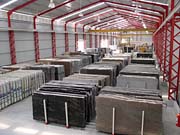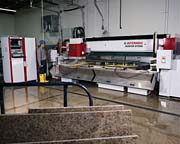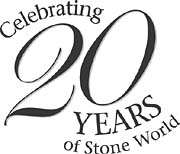
When the first issue of Stone World was published in November of 1984, the stone industry in the U.S. was quite different than it is today. Not only has the industry grown tremendously in volume, but it has also changed in terms of technology, distribution, application and beyond.
Because of the way stone is sold, it is difficult to gauge the actual size of the U.S. stone industry. In 2002, Catalina Research Inc. and Ceramic Tile and Stone Consultants (CTaSC) prepared a report estimating that a total of $3.3 billion worth of stone was consumed in the U.S. that year. This marked a 50% increase from 1998, when that total was estimated to be $2.2 billion. Looking back 20 years, a report from the U.S. Bureau of Mines estimated that stone consumption in the U.S. in 1984 was $362 million -- a mere 10% of what it is today.
While stone use in the U.S. has certainly grown, the applications have changed dramatically. Two and three decades ago, much of stone consumed in the U.S. was for commercial building projects. For many American stone importers, the 1980s was a decade of “Class A†office interiors -- where highly polished marble and brass accents ruled the day. Major stone cladding projects also took shape across the country, as limestone and granite towers shaped and re-shaped the skylines in cities such as Atlanta, Tampa, Los Angeles, New York and Chicago.
But the overbuilding of the 1980s all but dried up the market for U.S. high-rise construction in the 1990s. In the September 1996 Stone World article, “The decline of the American skyscraper,†Marlon Landry, a long-time industry veteran said, “Most of the skyscrapers are in the Far East. Other than the Far East, we're not doing the traditional towers anymore.â€
Still, the U.S. stone industry continued to grow, and this was achieved by adjusting to market trends. Natural stone was still being specified in large quantities, but for different types of applications. Stone was specified for civic work such as courthouses and libraries throughout the 1990s, including such large-scale stone projects as the Foley Square Courthouse in New York and the Cleveland Public Library. Stone also maintained its unyielding presence on institutional projects such as the San Francisco Public Library, Postal Square and the FDR Memorial in Washington, DC, and the Fernbank Museum in Atlanta, just to name a few. And continuing this country's tradition of building landmark structures in limestone, recent and ongoing projects include the National Constitution Center in Philadelphia, PA, the Federal Courthouse in Brooklyn, NY, and a new City Hall and Justice Center in
Seattle, WA.
On the commercial side, corporate campuses have been developed in markets such as Dallas, Southern California and Boston, and they are still making extensive use of natural stone to this day. (See “Stone palette brings visual interest to Pfizer campus,†on page 136 of this issue).
Of course, the skyscraper itself did not completely disappear, as evidenced by the NationsBank Building in Charlotte, NC, completed in the early 1990s by renowned architect Cesar Pelli, who used his favored Fior di Pesco marble from Italy.
Perhaps the greatest use of natural stone during the past 20 years can be found at the Getty Center in Los Angeles, which was designed by Richard Meier, who began working on the project in 1984 and saw it come to fruition over 13 years later, in December of 1997. The $1 billion, 945,000-square-foot project includes six buildings, and it utilized over 1 million square feet of Roman travertine.

The counter revolution
While the commercial market for natural stone has adjusted with the times, even more dramatic changes have come on the residential side over the past 20 years. Once thought to be a luxury item for very wealthy homeowners, granite kitchen countertops have moved into the mainstream, and they are being used in homes of virtually all income levels. “Big Box†retailers such as Home Depot and Lowes advertise granite countertops in radio, television and print ads, and consumer awareness of natural stone is at an all-time high.This development has dramatically changed the face of the stone industry in the U.S. New fabricators are coming into business virtually every day, and long-established firms are expanding with increased workloads. For the most part, the level of workmanship remains high, as many of these new endeavors are going about their business the proper way. They are carefully studying the trade and consulting established industry experts, who tend to be very good about sharing information.
Unfortunately, some new (and existing) firms have also been irresponsible in carrying out their workload. Complaints have included no-shows by templaters and installers. Difficult procedures such as sink cut-outs have been botched (and the defective countertop still installed). And, of course, estimates fell far short of the final bill. Although these incidents are relatively rare, they can hurt the reputation of an industry that is looking to continue a pattern of growth.
Maintaining the quality of natural stone countertops has become even more critical due to new entries to the industry. Looking to capitalize on the niche carved by natural stone countertops, man-made alternatives to granite have also become prevalent in the marketplace. In fact, a growing number of fabricators are working with both natural stone and quartz surfacing. Challenging the market share for natural stone, the manufacturers of these products -- such as Silestone and DuPont Zodiaq -- have deeper marketing budgets than the stone industry.
In response to this development as well as other issues, there has been some collaboration within the stone industry to generically market natural stone to the end user. Most notably, the Natural Stone Council was established to increase awareness and promote education about natural stone in North America. The Council had a strong presence at the American Institute of Architects Expo in Chicago, IL, with an elaborate booth displaying a broad range of stone applications (“Natural Stone Council draws a crowd at AIA 2004,†August 2004 Stone World, page 120). Also, working in conjunction with the Marble Institute of America, the Internet site www.usenaturalstone.com has been established to educate consumers on the stone selection and care, and it can even help homeowners find a contractor in their region.
Technology changes
Another tremendous change over the past 20 years has been the technology used by the American stone industry. Whether it is in the fabricating shop or on the jobsite, new machinery, tools and accessories have been developing on a continual basis.Following market trends, much of the new fabricating technology centers on producing kitchen countertops. Over the past 20 years, the costs involved with establishing a basic fabrication shop have become very manageable due to the advent of portable routers, which generally sell for under $6,000, depending on the features. And even though the cost is low, the quality that can be achieved is not compromised. In fact, many larger shops producing 20 or more kitchens per week still rely heavily on the portable routers for intricate work.
On the other end of the spectrum, Computer Numerically Controlled (CNC) technology has been an intriguing option for many stone fabrication shops. These multi-function units are being manufactured in Europe as well as the U.S., and they are offering an unprecedented level of automation. Stone fabricators are using these units for cutting, edge profiling, polishing and many other functions, and all of the tool changing is automatic.
When CNC technology first hit the stone industry, programming was a serious obstacle for many shops. In fact, some firms actually hired the CNC experts from the companies that sold them the machinery. Today, the programming has become more simplified, and companies are using advancements such as digitizing boards and more streamlined software to feed data into the CNC unit.
Also in this vein, waterjet cutting technology is seeing more prominence at fabrication facilities in the U.S. Developed around 20 years ago, this technology slowly moved gradually into the stone industry. Still, there were only a handful of stone fabricators using waterjet technology in the U.S. a decade ago. Today, it is much more prevalent, as many medium-sized fabrication shops have invested in waterjet technology.
Beyond CNC multi-function stoneworking centers and waterjet equipment, computerized technology is being used for other types of machinery, including edging units, profilers and bridge saws, among others.
Computerized stoneworking has also moved beyond the walls of the fabrication shop, as electronic templating and estimating software has become more and more popular -- particularly within the past two or three years. On the templating side, these systems minimize the human error in measuring and recording data, and many of them work seamlessly with the CNC technology at the shop. The estimating software has also streamlined operations for many fabricators, and they have been invaluable for inventory management.
Just as equipment has advanced, so has the tooling used within the fabrication shop. New products for cutting, routing, edging and polishing have been developed that are longer-lasting, work more efficiently and even eliminate steps in some cases. And while the industry as a whole has moved very gradually into diamond technology over the past 20 years, it is now commonplace for many operations in the fabricating shop.
Of course, the fabricators themselves have become more advanced in the way they do business over the past 20 years. Many companies have developed sophisticated bonus plans for their employees that maximized the level of production in their shops, but also made sure that the quality and efficiency of work would not be compromised. Fabricators are also providing their employees with 401k plans, extensive medical and dental benefits and other forms of profit-sharing plans.

Installation products and sealers
Over the past 20 years, the products used for treating, installing and maintaining stone have become more and more advanced. Whereas 20 years ago, many of the products being used to treat and install stone were actually intended for other materials, there are today many manufacturers in the U.S. and abroad that have developed extensive product lines specifically for natural stone.In the area of stone sealers, there is a seemingly endless array of products for treating stone. Most of these are formulated to reinforce the stone, and others also offer some aesthetic benefits, such as a matte finish or a wet look, as desired. Some penetrating sealers have allowed users of natural stone to reinforce the material while often leaving the appearance unchanged. As an additional benefit, the advent of sealers has allowed certain porous stones -- including some limestone and marble varieties -- to be used as countertops that would not have been possible 20 years ago.
Unfortunately, like other sectors of the U.S. stone industry, the success of the business has attracted some less-than-reputable companies to enter the arena of stone sealers, so it is imperative that users of these products make sure they are dealing with companies that have established a good reputation in the trade.
Stone setting systems have also enjoyed solid advancement over the past 20 years. There is new technology for waterproofing, soundproofing, crack isolation and other issues. Moreover, new adhesives allow installers to work faster and more efficiently, and they also offset jobsite challenges such as difficult substrates, bad weather or even foot traffic shortly after the installation.
One of the most recent developments in terms of adhesives is the advent of a mortar that allows large-format stone tiles to be installed vertically without mechanical anchoring. This product offers a new avenue for stone installation that might have otherwise been cost prohibitive.
Grouts have also been developing over the past 20 years, and today's manufacturers are offering stain-resistant grouts in a broader range of colors -- even some glow-in-the-dark options.
Resin-treated slabs
Again, relating back to the kitchen countertop trade, resin-treated slabs have become commonplace in the U.S. market. These slabs are typically produced overseas in countries such as Italy and Brazil, where large-scale plants specialize in applying resin and polishing. Manufacturers of these slabs have massive drying units to greatly speed the resin curing process, and they can hold up to 80 slabs at one time.Although polyester resins have been used in marble slab processing for more than 50 years, it was only over the past 20 years that epoxy resin systems were developed for granite.
The use of resins have allowed for the sale of materials that are naturally fractured and could not otherwise be sold or marketed. They also have the potential to reduce waste, and they address micro-fissures that compromise the final polished effect. From an aesthetic standpoint, end users of natural stone who desire a glass-like surface are satisfied.
For the most part, fabricators do not feel that working with resin-treated slabs is an obstacle, but they feel that there are issues that need to be addressed by the industry. To make the edges of the finished countertop match the resin-treated surface, a product must be used to enhance the color of the edge.
There have also been issues cited with regard to sealers, UV exposure, repair and other factors, but it appears that fabricators are coming up with solutions to these concerns as quickly as they arrive. Overall, they report that resin treatment is a much better solution than the cement filling procedures of old.

New stone sources
Another major change over the past 20 years is the way the U.S. sources stone. While Italy is still the top exporter of natural stone to the U.S. (totaling $422.6 million in 2003), other major players have also begun exporting directly to the U.S.China has seen a significant rise in its stone exports over the past 20 years. Major producers of Chinese stone have elevated their quality levels by working with advanced machinery from Italy, which has been reportedly mimicked by Chinese versions of the same equipment over the past few years. Last year, stone exports from China to the U.S. totaled $133.2 million, including $69 million of granite, $38.9 million of marble and $10.4 million of slate.
The export of Indian stone has also grown over the past 20 years, and last year it reached $139.7 million, including $97.3 million of granite, $10.4 million of marble and $31.2 million of slate (making India the top exporter of slate to the U.S., followed by China).
Spain is also a major exporter in all stone materials, as it exported a total of $106.3 million worth of stone to the U.S. in 2003, including $82.5 million of marble, $22.2 million of granite and $1.2 million of slate.
Italy's position as the top exporter of marble to the U.S. is being pressed by Turkey. While Italy exported $185.6 million worth of marble (including travertine) to the U.S. in 2003, Turkey was close behind, with exports of $175.8 million. The popularity of stones with a neutral, beige tone have been on boon for producers of Turkish travertine and marble, and Turkey's exports of these materials have increased tremendously over the past decade in particular.
Mexico has also emerged as a major supplier of marble and travertine to the U.S. Light and dark beige marble varieties are being quarried and fabricated in Mexico, and they are
being used for a broad range of applications -- from residential floor
tiles to upscale restaurants. They are particularly popular in a tumbled format, which allows end users to achieve an Old World aesthetic. Last year, exports of marble and travertine from Mexico to the U.S. totaled $92.5 million -- an all-time high and an eight-fold increase from 1993's total of $12.2 million.
Stone from Israel also entered the marketplace to meet the desire for beige materials with an Old World look. In particular, the many varieties of “Jerusalem Stone†have become very popular in the U.S. marketplace. Whereas exports of marble and travertine to Israel was less than $400,000 only 10 years ago, that figure last year reached $18.7 million.
On the granite side, Italy is the top exporter to the U.S., having shipped $228.3 million worth of granite here in 2003. However, Italy's position is being challenged by Brazil, which exported $179.4 million worth of granite to the U.S. last year, and that total has been rising significantly over the past few years. New sources of stone in Brazil are continually being explored, and the color choices and patterns are being expanded on a regular basis -- thus ensuring that rapid growth of Brazilian stone will continue in the U.S.
For better or for worse, the way stone is being sold in the U.S. is also starting to change. Whereas 20 years ago, most of the stone in the U.S. was sold through American importers and distributors, many fabricators are now going overseas themselves to source stone. Medium-sized and large fabricators can be found at overseas trade shows, slab yards and stoneworking plants, and they are importing slabs directly to their facilities in the U.S. Although there can be cost savings by importing direct, there is a trade-off involved. U.S. importer/distributors point to the advantage in terms of the quality, choice and customer service that comes from working with a distributor. At a “Fabricators Forum†during Coverings 2004, one fabricator summed up the cardinal rule when importing directly from overseas: “You have to find people who are reputable and people that you can trust.â€
The trade show explosion
Another area of growth -- and one that is becoming increasingly difficult to handle -- is the glut of trade shows in the U.S. and abroad. In 1984, there were no trade shows in the U.S. that were specifically geared toward natural stone. Then, in 1987, a group of equipment and tooling suppliers -- along with several stone North American trade associations -- got together to form StonExpo. At first, the show only allowed exhibitors of stoneworking machinery and accessories, but in 1993, they expanded their focus to also allow exhibits of stone products and setting materials. The StonExpo exhibition took another major step in 1996, when it began taking place jointly with the Marble Institute of America (MIA) Convention. The first joint event took place in Atlanta, and it has continued to the present time.The ceramic tile industry actually founded the basis for another major U.S. stone exposition. The International Tile Expo was renamed the International Tile & Stone Expo in 1993, and stone-related exhibitors have become an increasingly important component of the event. The show is now known as “Coverings,†and stone-related companies actually outnumber ceramic exhibitors. Taking place annually (usually in Orlando, FL), the show includes exhibits of stone in tile, slab and cut-to-size formats as well as displays of machinery, tools, setting products, sealers, adhesives and other specialty items.
Most recently, the International Tile & Stone Show (ITSS) has come forth, debuting in Las Vegas, NV, in 2002. The event's second edition in November 2003 showed significant growth over the first year, and the third Las Vegas showing took place last month, although results were not available at press time. Organizers of ITSS hosted a summer version of the show (with mixed results) in New York this past July, and they are ambitiously planning three versions of ITSS in 2005, with dates in Miami, New York and Las Vegas.
Also taking place annually in Las Vegas, Surfaces Expo, which has historically been a showcase of flooring materials such as carpet, hardwood floors and linoleum, has an increased presence of stone-related exhibitors, including natural stone products as well as installation materials and sealers.
While participation in trade shows can grow the industry, exhibitors and show attendees have indicated that there are too many domestic shows in the U.S. It remains to be seen, however, how the dates will be consolidated.
As if the trade show circuit in the U.S. was not busy enough, the foreign trade show calendar is also full, and these events have more American attendees than ever before. The leader among these foreign exhibitions is Marmomacc in Verona, Italy, which is the culmination of what had been two separate fairs -- Marmomacchine in Sant'Ambrogio, Italy, and Intermarmomach in Verona. This show attracts a solid number of American distributors and fabricators, who purchase both stoneworking machinery and natural stone products.
Also taking place in Italy, CarraraMarmomacc held its 25th edition in May of this year. Although this event draws less visitors than its counterpart in Verona, it offers people the opportunity to visit with some of the world's leading stoneworking firms, and it also sits in the shadow of the internationally renowned Carrara marble quarries.
In Germany, Stone+Tec Nurnberg takes place every two years, and it is considered to be an important event in terms of sheer size as well as in its solid international attendance. The quarries for Jura stone are only a short drive away from the fairgrounds.
The leading Spanish trade fair for stone today is Piedra, which debuted in 1996 and has the backing of the Spanish Natural Stone Federation. A decade ago, the major fair was in Seville, but it never reached the success of the Piedra event, which takes place every other year.
One of the fastest growing international fairs takes place in Vitoria, Brazil. Although a stone fair had been taking place in Cachoeiro de Itapemirim, Espirito Santo, Brazil, for over a decade, organizers began a second edition in the state's capital city of Vitoria, which offers greater infrastructure and access to many stoneworking facilities in the region. In fact, many major firms from Italy and Spain, among other nations, have developed their own stoneworking facilities in the Vitoria region, which also has a major shipping port.
The trade fairs in China also have a growing presence of U.S. attendees, including events in Beijing, Shanghai and Xiamen, although not at the level of the Vitoria fair in Brazil. Other international fairs for stone are taking place in such markets as London, England, and Izmir and Istanbul, Turkey, and they also offer their own niche to attendees.
Overall, it is a time of prosperity of the U.S. stone industry, as growth has defied a general economic downturn. However, as the industry continues to grow and evolve, caution must be taken to make sure that natural stone maintains its high standards workmanship and continues to be regarded as a premium building material.